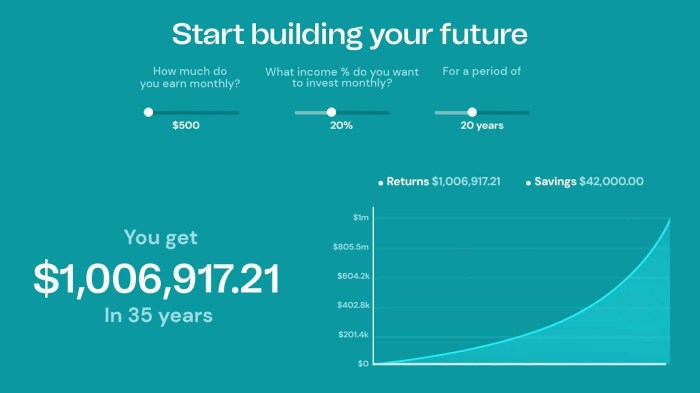8 crucial financial moves make your 30s the perfect time to lay the groundwork for a secure and prosperous future. This isn’t about stuffy spreadsheets or boring financial jargon; it’s about understanding your money and making smart choices that fit your life.
From establishing a solid budget and tackling debt to investing wisely and planning for retirement, this guide will equip you with actionable strategies to navigate the financial landscape of your 30s. Whether you’re single, coupled, or starting a family, these steps will help you build a financial foundation for a future you’ll love.
Establishing Financial Foundations in Your 30s
Your 30s are a crucial decade for solidifying your financial future. This is the time to build strong foundations that will support your long-term goals, from buying a home to saving for retirement. Taking proactive steps now can significantly impact your financial well-being in the years to come.Navigating the complexities of career advancement, potential family planning, and personal expenses requires a well-defined financial strategy.
This involves not just managing your current income, but also planning for the future, considering various potential scenarios.
Budgeting and Saving Strategies
Effective budgeting is the cornerstone of any successful financial plan. It allows you to track your income and expenses, identify areas where you can save, and make informed financial decisions. Creating a budget that aligns with your lifestyle and income is paramount.
- Prioritize Essential Expenses: Categorize your expenses into essential (housing, utilities, food) and discretionary (entertainment, dining out). Understanding where your money goes is the first step towards responsible spending.
- Track Your Spending: Utilize budgeting apps or spreadsheets to meticulously track your income and expenses for a month or two. This provides a clear picture of your spending habits and allows you to identify areas for potential savings.
- Develop Saving Habits: Establish a consistent saving routine. Even small, regular contributions can accumulate significantly over time. Aim for a savings goal, whether it’s an emergency fund, a down payment on a house, or a vacation.
Budget Templates and Saving Plans
Different income levels and lifestyles require different approaches to budgeting and saving.
- Low-Income Budget Template: Focus on minimizing non-essential expenses. Prioritize building an emergency fund. Explore potential government assistance programs or financial counseling services.
- Mid-Range Income Budget Template: Set aside a specific percentage of income for savings. Consider investing in low-cost index funds or ETFs. Start building a retirement fund, even if it’s a small amount.
- High-Income Budget Template: Diversify your investments to potentially maximize returns. Plan for significant future expenses, such as education costs for children or a large purchase.
Creating a Realistic Financial Plan for the Next 5 Years
A 5-year financial plan helps you visualize your goals and track your progress.
- Short-Term Goals (1-2 years): Focus on building an emergency fund, paying off high-interest debt, and saving for a significant purchase.
- Mid-Term Goals (3-4 years): Aim to increase savings for major purchases like a house or a car. Explore different investment options to potentially grow your capital.
- Long-Term Goals (5 years): Review your overall financial picture and adjust your plan based on any changes in your life circumstances. This might include adjusting your retirement savings plan or considering other investment options.
Investment Options
This table compares various investment options, considering their risk and potential return.
| Investment Option | Risk | Potential Return | Examples |
|---|---|---|---|
| Stocks | Moderate to High | High | Individual stocks, stock market index funds |
| Bonds | Low to Moderate | Moderate | Government bonds, corporate bonds |
| Real Estate | Moderate to High | High | Rental properties, investment homes |
“Diversification is key to managing risk in your investments.”
Debt Management and Reduction Strategies
High-interest debt, like credit cards and personal loans, can quickly snowball into a significant financial burden. Effective management and reduction strategies are crucial for achieving financial freedom and building a strong foundation for future financial goals. This section will explore proven methods for tackling debt, from crafting a comprehensive plan to understanding the nuances of various repayment approaches.Understanding your debt situation is the first step to developing a plan to effectively manage and reduce your debt.
So, you’re hitting your 30s and want to nail your finances? Eight crucial moves can really set you up for success. Beyond budgeting and saving, consider exploring an unexpected and effective way to find your true calling – like discovering a hidden passion through an unexpected and effective way to find your true calling. This could lead to higher earning potential and a more fulfilling career path, ultimately boosting your financial situation.
Focus on your 30s financial strategy now for a more secure future.
Categorize all your debts, including the principal balance, interest rate, and minimum payment. This detailed overview allows you to prioritize your repayment efforts and make informed decisions about your debt reduction strategies.
High-Interest Debt Management
High-interest debts, such as credit cards with variable APRs or personal loans with high interest rates, require aggressive strategies to reduce the overall cost and shorten the repayment timeline. Strategies include setting a budget to limit further spending and using every available resource to increase savings.
Debt Reduction Plan Creation
A debt reduction plan provides a structured roadmap for paying off your debts efficiently. It involves a detailed assessment of your debts, including the interest rate, minimum payment, and outstanding balance for each. Create a timeline and determine a realistic monthly payment amount that fits within your budget, factoring in other financial obligations.
Debt Repayment Methods Comparison
Different debt repayment methods offer varying approaches to prioritizing and managing debt.
- The debt avalanche method prioritizes debts with the highest interest rates. This approach minimizes the overall interest paid over time. For example, if you have a credit card with a 20% interest rate and a personal loan with a 10% interest rate, you would prioritize the credit card debt.
- The debt snowball method prioritizes debts with the smallest balances, regardless of interest rates. This method can provide a psychological boost and create momentum for debt reduction. For instance, if you have multiple credit cards, tackling the one with the smallest balance first might motivate you to continue the process.
Debt Consolidation and Balance Transfers
Debt consolidation involves combining multiple debts into a single loan with a potentially lower interest rate. Balance transfers, a form of debt consolidation, can offer a temporary reduction in interest payments, but be aware of transfer fees and the long-term implications.
Figuring out those 8 crucial financial moves in your 30s can feel daunting, but remember, your life path might surprise you. Sometimes, dreams evolve, and that’s perfectly okay – just like 5 reasons why it is alright if your dream changes. Adapting your financial strategy to match your changing goals is key, and those initial moves in your 30s will be critical to your future.
So, keep those financial foundations strong while embracing life’s unexpected turns.
- Benefits of debt consolidation include simplifying debt management, potentially lowering monthly payments, and streamlining the repayment process. Consolidating multiple debts can reduce the overall financial stress and allow for better budgeting.
- Drawbacks of debt consolidation include potential higher interest rates on the consolidated loan if the interest rate is higher than the average of the existing debts, hidden fees, and potential damage to your credit score if not done correctly.
- Balance transfers can provide a temporary reprieve from high-interest charges, allowing you to pay off smaller debts quickly. However, make sure to consider the transfer fees and the new interest rate of the balance transfer card. Avoid balance transfers if you anticipate not paying off the debt quickly, or you may incur higher interest charges.
Debt Management Tools and Services
Numerous tools and services can aid in debt management. Each has its own set of pros and cons, making informed comparisons critical for choosing the best option.
| Debt Management Tool/Service | Pros | Cons |
|---|---|---|
| Debt Consolidation Companies | Potentially lower interest rates, simplified payments | Hidden fees, higher interest rates, potential credit score impact |
| Credit Counseling Agencies | Debt management plans, budgeting assistance | Limited debt reduction, potential for temporary credit report impact |
| Online Budgeting Tools | Track expenses, set budgets, visualize spending | Requires discipline, may not solve underlying issues |
Building an Emergency Fund
A crucial step in achieving financial security is establishing a robust emergency fund. This safety net protects you from unexpected expenses, such as medical emergencies, job loss, or car repairs, allowing you to weather financial storms without accumulating debt or jeopardizing your long-term goals. Having an emergency fund is a proactive measure, demonstrating financial responsibility and resilience.Building an emergency fund is not just about saving money; it’s about building a financial cushion.
This cushion provides peace of mind, knowing you have a safety net to fall back on when unforeseen circumstances arise. It’s a key component of financial stability and a foundation for future financial endeavors.
Calculating Your Ideal Emergency Fund Amount
Determining the right amount for your emergency fund depends on your individual circumstances. Factors such as your income, expenses, and existing debts influence the ideal amount. A general rule of thumb is to aim for 3-6 months of living expenses. This amount allows for unexpected costs without needing to dip into other savings or take on debt.
Step-by-Step Guide to Building Your Emergency Fund
Creating a consistent savings plan is essential. A step-by-step approach will help you reach your target amount efficiently.
- Assess Your Current Financial Situation: Analyze your income and expenses to understand your current financial position. Identify areas where you can cut back on spending and allocate more towards savings. This involves tracking your income and expenses to identify potential savings opportunities.
- Set a Realistic Savings Goal: Determine the specific amount you want to save each month for your emergency fund. A smaller, consistent amount is often more achievable than a large lump sum. Break down your target into smaller, manageable savings goals. For example, saving $50 a week is more attainable than saving $200 a month.
- Automate Your Savings: Set up automatic transfers from your checking account to your savings account on a regular schedule. This ensures consistent savings without requiring constant reminders or willpower. Utilize online banking tools to schedule recurring transfers to your emergency fund account.
- Track Your Progress: Monitor your savings progress regularly. This will help you stay motivated and on track to reach your goal. Use budgeting apps or spreadsheets to track your progress.
- Review and Adjust: Periodically review your budget and savings goals. Adjust your savings plan as needed based on changes in your income, expenses, or financial goals. This will help you stay on track and avoid setbacks.
Different Savings Accounts and Their Features
Various savings accounts offer different features. Choosing the right account depends on your individual needs and priorities.
- High-yield savings accounts: These accounts typically offer higher interest rates compared to traditional savings accounts. They provide a significant advantage for maximizing your return on savings.
- Money market accounts: These accounts often provide a higher interest rate than traditional savings accounts and typically offer limited check-writing options. They combine features of savings and checking accounts, allowing you to write checks and use debit cards.
- Certificates of Deposit (CDs): CDs typically offer fixed interest rates for a specified period. While providing higher interest rates, CDs may come with penalties for early withdrawal.
Emergency Fund Scenarios and Financial Implications
Emergency funds provide a safety net against various financial setbacks.
- Job Loss: An emergency fund can cover living expenses during a period of unemployment. This prevents reliance on credit cards or loans and allows you to focus on finding a new job.
- Major Car Repair: A significant car repair can be expensive. An emergency fund can cover these costs without impacting other financial obligations.
- Medical Emergency: Unexpected medical expenses can quickly deplete your savings. An emergency fund can help pay for these costs without incurring debt.
- Home Repair: Unexpected home repairs can be costly. An emergency fund can help cover these expenses, preventing the need for loans or debt.
Investing for the Future

Investing in your 30s is crucial for building long-term wealth and achieving your financial goals. This stage often marks a shift from saving for emergencies to actively growing your capital. Smart investment strategies can significantly impact your future financial security. This section will Artikel key strategies for investing across various asset classes, emphasizing diversification and the power of long-term investments.Investing in your 30s is about more than just accumulating money; it’s about making informed decisions that align with your long-term financial objectives.
Understanding different investment vehicles and platforms is vital to effectively manage your portfolio and maximize returns. This section will provide insights into various investment options, helping you make well-informed choices.
Strategies for Investing in Different Asset Classes
Successful investing involves spreading your capital across diverse asset classes. This diversification mitigates risk and potentially enhances returns. Stocks, bonds, real estate, and precious metals are common examples. Each asset class carries a unique risk profile, and a balanced approach is often the most effective strategy.
- Stocks: Stocks represent ownership in a company. Investing in stocks can provide substantial returns over the long term, but also carries significant risk. Companies with strong growth potential often yield higher returns but also face greater volatility. Consider investing in companies with a proven track record and strong financial performance.
- Bonds: Bonds represent loans made to governments or corporations. Bonds typically offer lower returns compared to stocks but also carry lower risk. They can act as a crucial component in a diversified portfolio, providing stability and income.
- Real Estate: Real estate investment can offer steady returns through rental income or capital appreciation. However, it involves significant upfront costs and requires careful due diligence. Properties in high-demand areas or with strong rental potential are attractive options.
- Precious Metals: Gold and silver are often considered safe haven assets during economic uncertainty. Their value can fluctuate, and they may not always yield significant returns compared to other asset classes. They can provide a valuable hedge against inflation but aren’t a primary driver of long-term wealth generation.
The Importance of Diversifying Investments
Diversification is a cornerstone of successful investing. It reduces risk by spreading investments across different asset classes, industries, and geographies. A diversified portfolio is less susceptible to market fluctuations in a single sector or asset class.
- Reduces Risk: By distributing investments across various assets, you reduce the impact of negative performance in one area. If one investment underperforms, the overall portfolio may still perform well due to the positive returns from other investments.
- Potential for Higher Returns: A well-diversified portfolio can potentially yield higher returns over the long term compared to an investment concentrated in a single asset class.
- Mitigates Volatility: Diversification helps smooth out the ups and downs of the market, reducing the emotional impact of short-term fluctuations.
The Role of Long-Term Investments in Achieving Financial Goals
Long-term investments are essential for achieving significant financial goals, like retirement. The power of compounding returns over time is a key factor in building wealth. Consistent investment, even with small amounts, can yield substantial results over decades.
- Time Value of Money: The longer the investment timeframe, the more time your investments have to grow through compounding.
- Retirement Planning: Long-term investments are crucial for building a comfortable retirement nest egg. Early planning and consistent contributions can significantly enhance your retirement security.
- Financial Freedom: Long-term investments can provide financial freedom and independence, allowing you to pursue your passions and enjoy life’s experiences without financial constraints.
Different Investment Vehicles
Different investment vehicles offer various levels of risk and return. Understanding these vehicles can help you select investments suitable for your goals and risk tolerance.
- Index Funds: Index funds track a specific market index (like the S&P 500). They offer diversification and generally lower expense ratios, making them a popular choice for long-term investors.
- Mutual Funds: Mutual funds pool money from multiple investors to invest in a diversified portfolio of assets. They offer professional management but may have higher expense ratios than index funds.
- ETFs (Exchange-Traded Funds): ETFs trade on exchanges like stocks, offering diversification and lower expense ratios. They can track various indexes, sectors, or commodities.
Investment Platform Comparison
Choosing the right investment platform is crucial. Factors like fees, features, and user experience should be considered.
| Platform | Fees (Example) | Features |
|---|---|---|
| Platform A | 0.5% annual expense ratio | Wide range of investments, research tools |
| Platform B | 0.75% annual expense ratio | Robo-advisor services, educational resources |
| Platform C | 0.25% annual expense ratio | Focus on index funds, low-cost options |
Protecting Your Financial Future
Securing your financial future involves more than just saving and investing. A crucial aspect is safeguarding yourself against unforeseen events that could derail your financial progress. Insurance plays a vital role in this protection, offering a safety net for various life situations. Understanding the different types of insurance and how to choose the right coverage is essential for building a robust financial foundation.
Importance of Insurance
Insurance acts as a financial buffer against potential risks, protecting you from significant financial losses. Comprehensive insurance coverage can alleviate the burden of unexpected events like illness, injury, or loss of income, ensuring a smoother financial journey. It’s a proactive measure to maintain financial stability and peace of mind.
Types of Insurance Policies and Their Benefits
Various insurance policies cater to different needs. Health insurance safeguards your well-being by covering medical expenses. Life insurance provides financial security to your loved ones in case of your demise. Disability insurance ensures your income is protected if you become unable to work due to an illness or injury.
Choosing the Right Insurance Coverage
Choosing the right insurance coverage involves careful consideration of your individual circumstances and needs. Factors such as your age, health, family status, and income should all be considered. A financial advisor can help you assess your unique situation and tailor a plan that aligns with your goals. Review your current coverage and consider if it still meets your needs.
Comparing Insurance Providers and Their Offerings
Comparing insurance providers is essential to get the best value for your money. Research different providers and their policies to find the best fit for your budget and needs. Look at factors such as premiums, coverage limits, and customer service reputation.
Insurance Options and Costs
| Insurance Type | Description | Example Coverage | Estimated Monthly Cost (USD) |
|---|---|---|---|
| Health Insurance | Covers medical expenses | Doctor visits, hospital stays, prescription drugs | $200 – $500+ |
| Life Insurance (Term) | Provides a death benefit | $250,000 death benefit | $50 – $200+ |
| Life Insurance (Permanent) | Provides a death benefit and cash value component | $500,000 death benefit, cash value growth | $200 – $500+ |
| Disability Insurance | Replaces lost income due to disability | 60% of pre-disability income | $50 – $200+ |
Note: Costs are estimates and can vary significantly based on individual circumstances and policy details. Consult with an insurance professional for personalized quotes.
Retirement Planning in Your 30s
The 30s are a crucial decade for laying the groundwork for a comfortable retirement. While retirement might seem far off, starting early allows your savings to grow significantly over time thanks to the power of compounding. Proactive planning in your 30s can lead to substantial financial gains in the long run and prevent potential stress later.
Taking control of your retirement savings now will allow you to make informed decisions about your future. Understanding the various retirement savings options and their respective tax implications empowers you to make choices that align with your financial goals and risk tolerance.
Retirement Savings Options
Several avenues exist for retirement savings, each with its own set of advantages and disadvantages. Choosing the right option depends on your individual circumstances, income, and risk tolerance.
- 401(k) Plans: Many employers offer 401(k) plans, which allow pre-tax contributions. This reduces your current tax burden and can significantly boost your savings growth. The employer match, if offered, is a crucial element, acting as a substantial contribution to your retirement fund.
- Traditional IRAs: Traditional IRAs allow pre-tax contributions, providing tax benefits in the present while deferring taxes until retirement. These are ideal for individuals not covered by a 401(k) or for those seeking extra retirement savings beyond employer-sponsored plans.
- Roth IRAs: Roth IRAs offer after-tax contributions, but qualified withdrawals during retirement are tax-free. This structure can be beneficial for individuals anticipating a higher tax bracket in retirement. This option is best for those who expect their tax bracket to increase in the future.
Comparing Retirement Plan Features
Understanding the differences between various retirement plans is crucial for making informed decisions. The key characteristics to consider include contribution limits, tax advantages, and investment options.
| Feature | 401(k) | Traditional IRA | Roth IRA |
|---|---|---|---|
| Contribution Limits | Set annually by the IRS; often higher than IRA limits | Set annually by the IRS | Set annually by the IRS |
| Tax Deductibility (Contributions) | Pre-tax contributions; tax-deductible | Pre-tax contributions; tax-deductible | After-tax contributions; no tax deduction |
| Tax Treatment (Distributions) | Taxed in retirement | Taxed in retirement | Tax-free in retirement |
| Investment Options | Often a selection of mutual funds and stocks; depends on the plan | Variety of investments, including stocks, bonds, and mutual funds | Similar investment options to traditional IRAs |
Retirement Savings Strategies
Developing a retirement savings strategy requires a personalized approach. Strategies include consistent contributions, utilizing employer matches, and considering investment diversification.
- Consistent Contributions: Establishing a regular contribution schedule, even small amounts, is crucial for long-term growth. The power of compounding works best with consistent contributions over time. For example, starting with $50 per month in your 30s can grow significantly by retirement.
- Maximize Employer Matches: If your employer offers a 401(k) match, fully utilize this free money. It’s effectively “free” money, increasing your retirement savings without any additional effort.
- Investment Diversification: Distributing investments across different asset classes (stocks, bonds, real estate) helps mitigate risk and potentially increase returns. This strategy is important to balance risk and return, and diversify your investment portfolio.
Tax Implications of Retirement Savings
Understanding the tax implications of retirement savings is essential for optimizing your financial strategy.
Tax benefits often apply to contributions made to traditional retirement accounts. This means you pay less in taxes now, and the money grows tax-deferred until retirement. Withdrawals in retirement are then taxed as ordinary income. Roth accounts, on the other hand, are funded with after-tax dollars, but qualified withdrawals in retirement are tax-free.
The choice of retirement account depends on your current and anticipated tax bracket, as well as your risk tolerance.
Home Ownership or Renting Decisions: 8 Crucial Financial Moves Make Your 30s
Navigating the complexities of homeownership versus renting in your 30s is a significant financial decision. This crucial choice impacts your budget, long-term savings, and overall financial well-being. Weighing the advantages and disadvantages of each path is essential for making an informed choice aligned with your individual circumstances and aspirations.Understanding the pros and cons of each path is paramount for effective decision-making.
Homeownership offers potential equity building and tax advantages, but also involves significant upfront costs and ongoing responsibilities. Renting provides flexibility and lower initial costs, but sacrifices the potential for long-term financial growth.
Factors to Consider When Deciding
Several factors play a critical role in determining whether buying or renting is the right path. Personal financial stability, long-term goals, and current market conditions should be carefully considered. The decision isn’t solely financial; lifestyle preferences and family plans also influence the choice.
Financial Implications of Homeownership
Homeownership entails substantial upfront costs, including a down payment, closing costs, and potential pre-purchase home inspections. Ongoing expenses include property taxes, homeowner’s insurance, mortgage payments, and maintenance. These costs can vary significantly based on the location and condition of the property.
Financial Implications of Renting
Renting typically involves lower initial costs compared to buying a home. Monthly rent payments are a recurring expense, and there are no upfront costs like a down payment. However, rent payments don’t build equity or offer the same tax advantages as homeownership.
Examples of Financial Considerations
Consider a young professional earning $60,000 annually. If they choose to rent, their monthly rent might be $1,500. This leaves them with more disposable income, enabling them to save for other financial goals.Alternatively, if they choose to buy a home, their monthly mortgage payment, including property taxes and insurance, could be $2,000. This could reduce their savings potential for other goals.
So, you’re hitting your 30s and want to nail your finances? Knowing yourself is key. First, consider these 8 crucial financial moves. But before diving in, take a hard look at yourself – honestly! Understanding your spending habits, and being transparent about your financial goals is vital. For example, check out this insightful post about 7 crucial things you need honest about 7 crucial things you need honest about to get a better grasp of where you stand.
Ultimately, that self-awareness will help you make smarter financial decisions in your 30s and beyond.
Comparison of Costs
| Cost Category | Buying a Home | Renting a Home |
|---|---|---|
| Down Payment | Typically 10-20% of the home’s purchase price | None |
| Closing Costs | Closing costs can vary, typically 2-5% of the loan amount | None |
| Property Taxes | Annual property taxes are dependent on local rates | None |
| Homeowner’s Insurance | Annual insurance premiums depend on location and home value | None |
| Mortgage Interest | Interest rate payments vary according to loan terms and credit score | None |
| Maintenance Costs | Repair and maintenance costs are the responsibility of the homeowner | None |
| Monthly Rent | N/A | Monthly rent payments |
This table highlights the key differences in costs associated with buying versus renting a home. It illustrates the significant upfront and ongoing expenses of homeownership, contrasting with the relatively simpler cost structure of renting.
Managing Finances with a Partner or Family

Navigating the financial landscape as a couple or family unit requires a unique approach. Shared goals, combined resources, and open communication are paramount for long-term financial well-being. This section explores key strategies for couples and families to effectively manage their finances together.Financial planning for couples and families is more than just combining incomes; it’s about building a shared financial future.
Successful couples and families often prioritize open communication, shared goals, and collaborative decision-making to ensure financial stability and achieve their individual and collective aspirations.
Financial Planning Strategies for Couples, 8 crucial financial moves make your 30s
Effective financial planning for couples involves a deep understanding of each other’s financial habits, goals, and expectations. Understanding these aspects fosters a collaborative environment where decisions are made with mutual agreement. This includes understanding each other’s risk tolerance and investment philosophies, which are often crucial for long-term financial success.
Open Communication about Finances
Open and honest communication about finances is essential for building trust and ensuring everyone feels comfortable discussing financial matters. This includes openly discussing expectations, concerns, and goals. Transparent financial discussions foster a shared understanding of financial responsibilities and priorities. Regular financial check-ins and discussions about spending, saving, and debt reduction strategies are beneficial.
Joint Budgeting and Savings Plans
Creating a joint budget and savings plan is a cornerstone of successful financial partnerships. A shared budget helps track income, expenses, and savings goals. Joint savings accounts for specific goals like a down payment on a home or retirement can provide a tangible representation of progress. Detailed budgeting spreadsheets and online budgeting tools can help in this process.
For example, a joint budget can track individual expenses and allocate funds for shared household expenses. A separate savings account for large purchases or emergencies can provide peace of mind.
Handling Financial Disagreements
Disagreements about finances are inevitable, but they can be navigated constructively. Developing strategies for resolving disagreements is critical for maintaining a healthy financial relationship. Setting clear financial expectations and establishing a system for resolving conflicts, such as a mediation process, is highly recommended. Compromise and a willingness to understand each other’s perspectives are key. This often involves active listening, seeking common ground, and finding solutions that benefit both partners.
Financial Documents to Share
Sharing relevant financial documents with your partner or family members builds transparency and trust. This includes sharing important documents like bank statements, investment records, tax returns, and insurance policies. The level of transparency depends on the specific relationship and the comfort levels of each individual. However, sharing relevant information helps in making informed decisions.
| Document | Importance |
|---|---|
| Bank Statements | Tracks income and expenses, reveals spending patterns. |
| Investment Records | Shows portfolio holdings, investment strategies, and returns. |
| Tax Returns | Provides a complete picture of income, deductions, and liabilities. |
| Insurance Policies | Shows coverage amounts, policy details, and premium payments. |
| Debt Records | Tracks outstanding debts, interest rates, and payment schedules. |
Last Point
This journey through 8 crucial financial moves in your 30s isn’t about reaching a destination, but about developing a proactive and sustainable financial mindset. By building a strong financial foundation now, you empower yourself to achieve your goals and live a life filled with freedom and financial security. Remember, every small step counts, and the earlier you start, the greater your rewards will be.
So, take control of your finances today and start building a brighter tomorrow.











